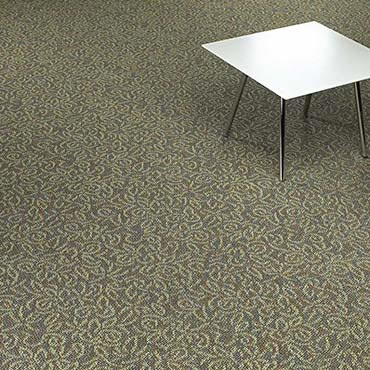Mannington commercial flooring has been recognized as a leader in product innovation, styling, and design, as well as in operational excellence and environmental stewardship. With industry-leading fiber systems and superior manufacturing, our vast array of carpet styles look better and last up to 75% longer than any other carpet in the marketplace. Learn More
Commercial Cut and Uncut (Texture)
Commercial Cut and Uncut (Texture) Guide

The Rising Star in Commercial Interiors: Textured Cut/Uncut Carpet
In the dynamic world of modern interior design and architecture, the choice of flooring plays a pivotal role in defining the ambiance and functionality of commercial spaces. Among the plethora of options available, Textured Cut/Uncut Carpet has emerged as a versatile and aesthetic choice for architects, interior designers, specifiers, and commercial buyers. This article delves into the significance of this carpeting style, its types, versatility, durability, sustainability, and how it enhances commercial spaces.
Understanding Textured Cut/Uncut Carpet
Textured Cut/Uncut Carpet is a unique style where the pile is a mix of cut and uncut loops, creating a distinct texture and pattern. This blend offers an appealing tactile experience and adds a dimension of sophistication to the floor design. The variety ranges from subtle textures that lend a refined elegance to bold patterns that make a statement.
Types and Versatility
The versatility of Textured Cut/Uncut Carpets is one of its standout features. They come in various fiber types, colors, and patterns, making them suitable for a wide range of commercial settings, from corporate offices and hotels to retail spaces and educational institutions. This versatility allows designers to create bespoke environments that reflect a brand's identity or a space's intended use.
Durability and Maintenance
In commercial settings, durability is paramount. Textured Cut/Uncut Carpets are known for their resilience. The mixed pile height and texture offer excellent resistance to wear and tear, making them ideal for high-traffic areas. Furthermore, advancements in fiber technology and treatments have enhanced their stain and dirt resistance, making maintenance easier.
Sustainability: A Key Consideration
Sustainability in commercial interior design is not just a trend but a necessity. Many Textured Cut/Uncut Carpets now incorporate eco-friendly materials, such as recycled fibers, and are produced using sustainable methods. This shift not only reduces the environmental impact but also appeals to environmentally conscious businesses and consumers.
Enhancing Commercial Spaces
The aesthetic appeal of Textured Cut/Uncut Carpet is undeniable. Its unique texture adds depth and interest, enhancing the overall design of a space. It can also contribute to the acoustic comfort, an important aspect in commercial environments. By absorbing sound, it creates a more conducive atmosphere for work, conversation, and concentration.
Selecting the Ideal Carpeting
For professionals in architecture and interior design, selecting the right Textured Cut/Uncut Carpet involves considering several factors:
- Traffic and Use: Assess the level of foot traffic and the nature of activities in the space to determine the durability required.
- Design and Aesthetics: Choose a style and color that complements the interior design scheme and reflects the space's purpose.
- Maintenance Requirements: Consider ease of cleaning and the need for regular maintenance.
- Sustainability: Opt for options with eco-friendly credentials to align with sustainability goals.
Features and Benefits
The key features of Textured Cut/Uncut Carpeting include:
- Aesthetic Appeal: The unique texture enhances the visual interest of the space.
- Acoustic Comfort: Improves sound absorption, contributing to a more pleasant environment.
- Durability: Suitable for high-traffic areas, offering longevity.
- Comfort: Provides a comfortable walking surface, which can be beneficial in workplaces and public spaces.
- Health and Safety: Some options come with anti-microbial treatments, contributing to healthier indoor environments.
Trends and Innovations
The industry is witnessing exciting trends and innovations in Textured Cut/Uncut Carpeting:
- Eco-Friendly Materials: Use of sustainable materials like recycled plastics and natural fibers.
- Advanced Dye Technology: Enhanced color vibrancy and patterns with improved fade resistance.
- Integrated Technology: Carpets embedded with smart technology for interactive spaces.
- Hybrid Textures: Combining different materials and textures for unique tactile experiences.
In conclusion, Textured Cut/Uncut Carpeting is a significant element in modern commercial interior design and architecture, offering a blend of aesthetic appeal, durability, and versatility. Its ability to adapt to various design requirements, coupled with its sustainability credentials, makes it an ideal choice for contemporary commercial spaces. As the industry continues to evolve with new trends and innovations, Textured Cut/Uncut Carpeting remains a key player in creating functional, stylish, and sustainable commercial environments.
Disclaimer: The information provided in this article is for general informational purposes only. While we strive to ensure the accuracy and reliability of the information presented, we make no warranties, express or implied, about the completeness, accuracy, reliability, suitability, or availability with respect to the content. Any reliance you place on such information is strictly at your own risk. We recommend consulting with professionals for specific advice tailored to your project’s needs, particularly regarding building codes, regulations, and product specifications.
Under no circumstances shall we be liable for any loss or damage, including without limitation, indirect or consequential loss or damage, arising from the use of, or reliance on, the information provided in this article.
Featured Brands
The Best 1 Commercial Cut and Uncut (Texture) Brands

Mannington Commercial Carpet
Profile | Website | GreenMannington commercial flooring has been recognized as a leader in product innovation, styling, and design, as well as in operational excellence and environmental stewardship. With industry-leading fiber systems and superior manufacturing, our vast array of carpet styles look better and last up to 75% longer than any other carpet in the marketplace. Learn More
